New program keeps junked boats at bay
October 20, 2011
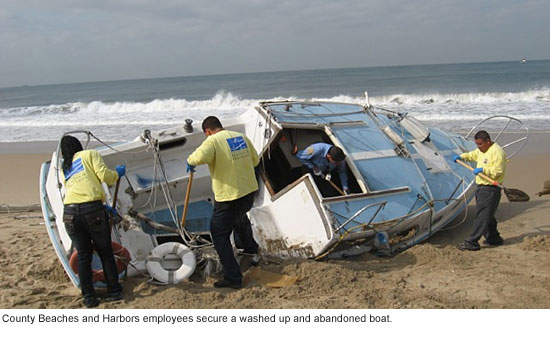 As the economy flounders, a new Los Angeles County program will soon be sending a message to boaters: Please don’t abandon ship.
As the economy flounders, a new Los Angeles County program will soon be sending a message to boaters: Please don’t abandon ship.
Abandoned boats have become a vexing problem in the past several years as owners unable to sell or maintain their vessels give up and walk away from them, sinking them in local harbors, ignoring them until they break from their moorings or allowing them to rot in their slips.
“People get into boating thinking it’s going to be inexpensive,” says Deputy Bryan White of the Los Angeles County Sheriff Department’s marine operations division. “But nothing about boating is inexpensive.”
And abandoning a boat just passes on the costs to the public at large.
“We have to move it out of harm’s way so that it’s not a public nuisance, then we have to store it, then we have to go through a long process to find the owner and do a lien sale auction if the owner doesn’t’ show up,” says county Director of Beaches and Harbors Santos H. Kreimann.
If the boat has been sunk, as many are—usually after being stripped of identification—there’s the cost of retrieval and environmental mitigation. Most of the time, he says, the boats are in such bad shape by the time they’re found that they’re simply stripped and crushed, again at public expense.
Meanwhile, each boat represents four to six months or more of work for public employees. The typical abandoned boat costs taxpayers about $5,000 in staff work and another $2,000 to process the lien sale, Kreimann says.
“It’s become a worsening problem,” he says. Last year, according to the Sheriff’s Department, the county disposed of 24 abandoned boats that had been left in the marina, sunk in local waters or allowed to wash up on county beaches, but authorities expect that number to rise to 30 or more this year.
For some time, the county has underwritten the cost of the problem with grants from a state fund earmarked for the abatement of abandoned recreational watercraft. This year, however, the county is also tapping into a second state program to encourage owners to voluntarily turn in their vessels before they reach the point of abandonment.
The pilot Vessel Turn-In Program, or “VTIP”, allows owners to surrender unwanted boats without any penalty if they’re thinking of walking away, says Denise Peterson, boating law enforcement manager for the state Department of Boating and Waterways, which administers both programs.
The idea, she says, is to save money on the boat disposal by retrieving more boats from slips, rather than from underwater or public beaches, where the retrieval and storage can be up to ten times more costly and much more complex.
“The marinas usually know who’s delinquent on slip fees, or soon-to-be delinquent,” she says. “This program allows them to reach out to these owners and say, ‘Don’t worry, you’re free and clear, let us take care of it. It saves a lot in administrative costs.”
This week, the Board of Supervisors approved a $1,700 county match requirement for a $17,000 grant that will allow Los Angeles County to launch a VTIP program this year. A second vote enabled the county to access some $50,000 in state funds for the disposal of at least ten boats that have already been abandoned, a substantial increase from the county’s state grant last year.
White, who administers the abandoned watercraft grants out of the sheriff’s Marina Del Rey station, says the department plans to contact dock masters to “to see who’s in distress and trying to get rid of their boats”.
Members of the public who are considering boat abandonment also are invited to contact the department about the program at (310) 482-6033.
Posted 10/20/11
Clean beach, clear mind
October 20, 2011
Want to start the weekend on a positive note? Join a beach cleanup in Venice and you’ll be rewarded—not only with the satisfaction of environmental stewardship but with free yoga and tai chi lessons, too.
The lessons will be provided by Heal One World, a nonprofit group that offers non-traditional and preventative healthcare at low or no cost. For this cleanup the organization will team up with Heal the Bay, which will handle the beach clean-up logistics, and Venice Family Clinic, which partners with Heal One World in providing health services.
If you want to participate, show up at the Rose Avenue entrance to Venice Beach this Saturday, October 22, at 9 a.m., and register for the clean-up. Bags and gloves will be provided, but you can help cut down on waste by bringing your own gloves, and a bag or bucket from home. In addition, you should bring a yoga mat, appropriate clothing and ample drinking water. The yoga and tai chi instruction begins at 10 a.m.
Posted 10/20/1
Experts onboard with Westside Subway
October 19, 2011
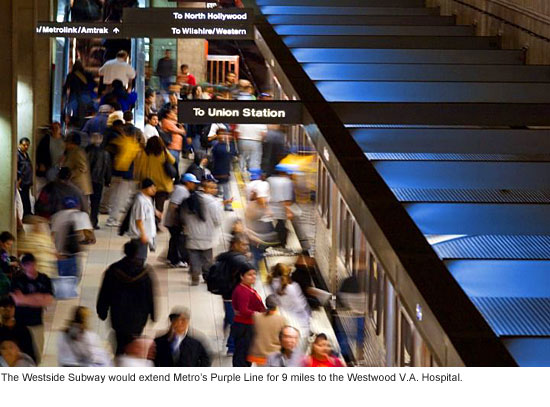 A key stretch of the Westside Subway could safely be built under the Beverly Hills High School campus, a high-profile panel of experts told a Metro committee Wednesday after reviewing the results of extensive testing for earthquake hazards, vibration and noise, subterranean methane gas and abandoned oil wells.
A key stretch of the Westside Subway could safely be built under the Beverly Hills High School campus, a high-profile panel of experts told a Metro committee Wednesday after reviewing the results of extensive testing for earthquake hazards, vibration and noise, subterranean methane gas and abandoned oil wells.
On all counts, the experts said, subway tunneling under the school could be accomplished without endangering students or others, without undermining the school’s role as an emergency evacuation center and without interfering with plans to one day remodel the campus to include an underground parking garage or other buildings.
Significantly, the experts also concluded that it would be dangerous to build the Century City subway station on Santa Monica Boulevard, one of two locations under consideration, because of the presence of two active earthquake faults, one running parallel to Santa Monica Boulevard. The other potential Century City station site—at Constellation Boulevard and Avenue of the Stars—is not on an active fault and thus remains a viable option for a station, the experts said.
The experts’ testimony before the Metro board’s Planning and Programming Committee could play a pivotal role in the subway’s planning. While the committee members took no positions Wednesday on what they heard during the briefing, the question of where to place the Century City station has been a matter of heated debate, with many in Beverly Hills vigorously opposing the Constellation station because the route to get there would pass under their city’s high school campus.
Those testifying included not just experts from project’s tunneling advisory panel but also members of a specially-convened group of prominent independent reviewers brought in to assess the soundness of the research.
One of the independent experts, seismologist Lucy Jones of the U.S. Geological Survey and Caltech, said her group “completely agreed with” the conclusion that “the Santa Monica Boulevard station sites would be dangerous to build on.”
At the same time, she emphasized that it is possible to safely to build tunnels through earthquake zones by having the tunnels cross the faults at a sharply perpendicular angle. That would be the case in the route involving the Constellation station.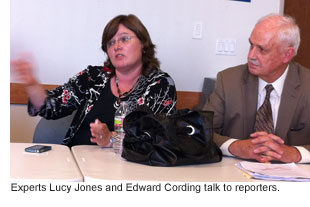
“To build a subway in Los Angeles, you can’t avoid earthquakes,” Jones said. “They’re going to be here. And you cannot avoid faults. You can, however, build effectively around faults and it’s been done in a lot of locations: in Los Angeles, in San Francisco, Mexico City…What you’ve got to try to do is to put your tunnels at a high angle, close to perpendicular to the faults, and avoid ever putting a station in a fault.”
Also testifying was consulting earthquake geologist James Dolan, a professor of earth sciences at USC who is among the project’s fault experts. (For a full list of the experts, click here; their full reports are now posted here, along with a letter on their findings.)
Supervisor Zev Yaroslavsky, a member of the Metro committee, said bringing in an independent expert peer review panel made up of “people that the public knows and recognizes” was important and, “given the rhetoric that’s been freely flowing out of Beverly Hills,” could help alleviate concerns about the impartiality of the scientific research.
And he stressed the significance of what’s at stake.
“This has to be a decision, when we make it, that has to be based on science and facts, not based on what we feel or think based on our gut,” Yaroslavsky said. “This is a very expensive decision that we’re going to make. It’s a profound decision both in terms of planning and in terms of finances. If we build a station in the wrong place and three months after we build the station we have an earthquake and the station is destroyed and people are killed, we have an issue.”
Beverly Hills Mayor Barry Brucker attended the committee meeting and said afterward that he found the presentation impressive. Still, he said it is important to have the city’s own experts review the scientific reports, particularly when it comes to the finding of no active faults at the Constellation Boulevard site.
“I’m not skeptical of the science but we are going to have our consultants get all that data,” Brucker said. “It’s just good prudent governance to have a second independent peer review that we commission.”
In a statement, Beverly Hills Unified School District president Lisa Korbatov said Metro had opened a “veritable Pandora’s box” with the seismic data presentation, and said the agency had held on to the data for too long without sharing it with the public.
Metro CEO Art Leahy responded with his own statement Thursday morning, saying that key information was made public soon after it was first analyzed. “Within just the past few months,” Leahy said, “our technical experts have located precisely long-suspected fault features. Their work was reviewed and confirmed yesterday by independent reviewers I engaged six weeks ago.”
Supervisor Michael D. Antonovich, also a member of the Metro committee, asked during the meeting how much the experts were being paid. Metro officials said they were unable to immediately provide the figure but said it was part of the project’s overall budget. After the meeting, Jones said that, as a U.S. government employee, she was not being compensated for her work but was doing it as part of her job.
The Metro board last year approved the subway project’s draft environmental impact statement/report, with a proposed route that included the two possible locations for the subway’s Century City station.
At the same time, the board approved a motion by Yaroslavsky calling for a thorough review of all the potential risks around the high school and throughout West Beverly Hills, Century City and Westwood.
Wednesday’s oral report to the board committee represents the first public accounting of what the experts found. Their assessment will be included in the project’s final environmental impact statement/report, expected to be released this winter.
After a final round of public comments, Metro’s board is expected to vote on the project early next year. As currently envisioned, the Westside Subway would be a 9-mile extension of Metro’s Purple Line, with seven new stations ending at the Westwood V.A. Hospital.
Some construction could begin as early as 2013. If completed by 2022, the project could cost an estimated $5.3 billion. Funding will come in part from Measure R, the ½-cent sales tax approved by county voters in 2008, but federal money will also be required.
Here, based on testimony and executive summaries posted Wednesday, are some of the experts’ conclusions:
There is “no reasonable tunnel alignment” that could avoid passing under any structures on the Beverly Hills High School campus. (A presentation during the meeting showed that the tunnel would only run under Building B of the high school’s south wing, not the gym/pool building.) The depth of the tunnel—55 to 70 feet below the surface—would allow space for a future structure such as an underground parking lot to be built above it, the summary said.
Vibration from subway trains traveling under the campus would be 64 decibels or less—below the federal threshold of 72 to 75 decibels. The noise level would be no greater than 33 decibels, less than the federal standard of 35-40 decibels.
Advances in tunneling—notably through the use of pressurized closed-face tunnel boring machines—will minimize the risk of ground settlement during the project and were successfully used in building the Metro Gold Line’s Eastside Extension, the summary said.
Tunnels would be built to “maximum design earthquake” standards using the closed-face tunnel boring machines and special water-tight and gas-tight liners. “Since the tunnels will be designed to not collapse during an earthquake, the tunnels will affect neither the threat to buildings above active faults during an earthquake nor the severity of the shaking,” the executive summary said. Thus, there would be no effect on the high school’s role as an emergency evacuation center.
As for abandoned oil wells on the campus, magnetic testing found “one anomaly” on the west edge of the school’s lacrosse field that may or may not be the metal casing from an abandoned well. Hi-tech advance testing would enable construction to safely work around the obstruction if it turns out to be an inactive well, the report said. It also noted that an abandoned oil well that appears on maps of the area is located under a parking structure on Century Park East, not under the high school.
Almost the entire project is located within the city of Los Angeles’ “methane zone,” and testing for methane and hydrogen sulfide gas around Constellation Boulevard found concentrations that “could be explosive under unfavorable conditions.”
However, advances in machinery, technology and regulation—and decades of tunneling industry experience—have made it possible to tunnel safely through gassy ground. The report also noted that higher levels had been found, and successfully overcome, during construction of the Red Line in downtown Los Angeles.
Overall, the summary said, “The project is not expected to pose new threats to the students, faculty or community as a result of its construction and operation.”
Posted 10/19/11
Want an early Halloween scare? Go fish
October 17, 2011
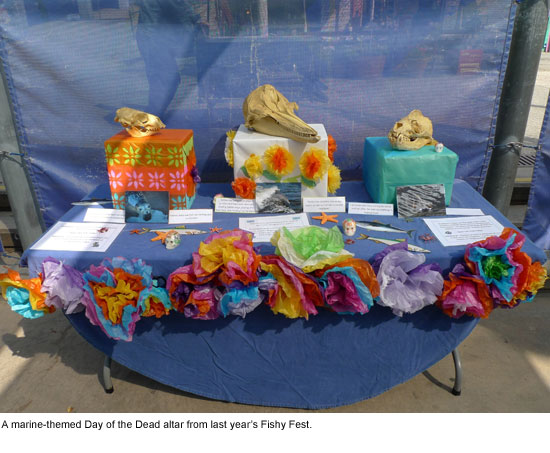 Halloween and Dia de los Muertos start a bit early at the Santa Monica Pier Aquarium, where something fishy will be going on this weekend.
Halloween and Dia de los Muertos start a bit early at the Santa Monica Pier Aquarium, where something fishy will be going on this weekend.
The Fishy Fest combines spooky entertainment and conservation-minded education. There will be a marine animal graveyard, Dia de los Muertos crafts and altars, face painting and more. Learn about bioluminescence (light production by living creatures) from marine experts, or take a look at parasites of the sea with “Invasion of the Body Snatchers.” If you’re there at 3:30 p.m. Sunday, you’ll be able to catch the always-popular shark feeding.
Regular aquarium exhibits also will be open for the event. There are tanks with live specimens to feel and observe, presentations by naturalists and displays containing more than 100 different marine species. The aquarium performs public education for the local conservation group Heal the Bay.
The Fishy Fest will take place from 12:30 p.m. to 5 p.m. this Saturday and Sunday, October 22 and 23. The Aquarium is located at the beach level of the Santa Monica Pier, 1600 Ocean Front Walk. Children under 13 are free with an adult, and all others are admitted for a suggested donation of $5, or a $3 minimum entry fee. Costumes are welcome and encouraged, so put on your axe-wielding octopus outfit and get in the, er, swim of things.
Posted 10/17/11
Surfing with the stars
October 14, 2011
Channel surfers, here’s your chance to see some real action in the Santa Monica Bay.
Stars and surfers will paddle out this weekend for the Fourth Annual SOS (Save Our Surf) Celebrity Surfathon. Twelve teams of 24 surfers will take turns riding waves, with a goal of raising money for Santa Monica Baykeeper, Waves for Water, Inside the Outdoors and Tumelo Home. Teams and individuals that raise the most money win prizes.
Celebrities listed as attending include John Slattery (Mad Men), Jesse Spencer (House), Galen Gering (Days of Our Lives) and Kathy Zuckerman (Gidget). They will join pro surfing notables including Jon Rose, Mary Osborne, Don Bigelow and Buttons Kaluhiokalani.
Gawkers won’t be left out of the fun, either. Attendees of all ages can enjoy live music, mural painting, yoga, guest speakers, eco-friendly exhibits and autograph sessions with the pirate cast from the “Pirates of the Caribbean” movies.
The surfathon takes place Saturday and Sunday, October 15 and 16, from 8 a.m. to 5 p.m. each day. It all happens south of the Santa Monica Pier at Lifeguard Tower 28, adjacent to Ocean Park & Barnard Way. On both days, pro surfers take to the water from 9:30 a.m. to 10:15 a.m. and celebrities surf from 10:15 a.m. to 11 a.m. The event is free to watch, or you can join in by donating to the nonprofit group Save Our Surf, which organizes the event.
Posted 10/14/11
Waxing poetic at the museum
October 14, 2011
Writers celebrate California literary culture and pay homage to their poetic predecessors tonight at UCLA’s Hammer Museum. The Festival of California Poets features Maxine Hong Kingston, Suzanne Lummis and James Ragan, who will read their works and the works of luminaries Lucille Clifton, Nora May French and Denise Levertov. A question-and-answer period will follow the readings, and three more poets will perform a second installment on Sunday in Pasadena.
In addition to her poetry, Kingston has written several novels and nonfiction books on Chinese immigrant life and feminism, among other topics. Lummis is director of the Los Angeles Poetry Festival and has contributed to the development of “poem noir,” an urban fusion of poetry and film noir. James Ragan has recited his socially conscious verse in front of heads of state and at the United Nations.
The Festival of California Poets is produced by the PEN Center USA, which supports literary communities around the world with everything from anti-censorship advocacy to mentorship programs.
The Hammer Museum is located at 10899 Wilshire Boulevard in Westwood. Admission is free, and the show starts at 7 p.m. on Friday, October 14. Parking under the museum is $3. Arrive early to ensure a good seat.
Posted 10/14/11
A look behind the bars
October 13, 2011
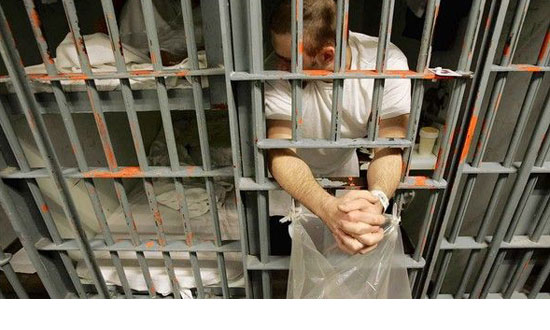 In recent weeks, we’ve seen a steady and serious stream of allegations involving excessive force inside Los Angeles County’s jail system, allegations that are undermining public confidence in our commitment to the constitutional protections afforded inmates.
In recent weeks, we’ve seen a steady and serious stream of allegations involving excessive force inside Los Angeles County’s jail system, allegations that are undermining public confidence in our commitment to the constitutional protections afforded inmates.
Media and advocacy organizations have detailed numerous cases of alleged inmate mistreatment that, if true, suggest a breakdown of accountability and discipline within the agency that runs the jails, the L.A. County Sheriff’s Department. These incidents are notable not only because of the alleged ferocity of the beatings but because some of them were reported by civilian observers who say they were shocked and scared by what they witnessed.
Allegations of brutality in the nation’s largest jail system are not new, and the Sheriff’s Department itself can rightly point to a history of firing and disciplining deputies who’ve been accused of excessive force. I feel confident that the vast majority of deputies are conducting themselves appropriately in the stressful environment of our overcrowded lock-up. But there appears to be a certain brazenness in these recent cases that raises questions about whether a culture of disregard for the constitutional rights of inmates is taking root among some deputies.
Currently, the FBI is investigating this alleged mistreatment of prisoners, and Sheriff Lee Baca has assembled an in-house task force to examine, or reexamine, a number of alleged incidents compiled by the ACLU and others. I’m confident that these will lead to disciplinary action and criminal prosecutions if warranted.
Still, more is needed. The Board of Supervisors is responsible to the taxpayers and to the broader community for the safe, efficient and constitutional operation of our jail system. To that end, Supervisor Mark Ridley-Thomas and I will introduce a motion at the board’s Tuesday meeting urging our colleagues to create a Citizen’s Commission of five distinguished county residents to “conduct a review of the nature, depth and cause of the problem of inappropriate deputy use of force in the jails, and to recommend corrective action as necessary.”
It also would be the responsibility of the commission’s five members, each one appointed by a member of the Board of Supervisors, to hold the sheriff and the board accountable for the “speedy and effective implementation” of potential solutions.
As Supervisor Ridley-Thomas and I write in our motion: “It is the Sheriff himself, as head of the department, and the members of the Board of Supervisors as the ultimate decision-makers for the County, who will be held accountable for the quality and constitutionality of law enforcement services to the county.”
Posted 10/13/11
Better buy a ticket to ride
October 13, 2011
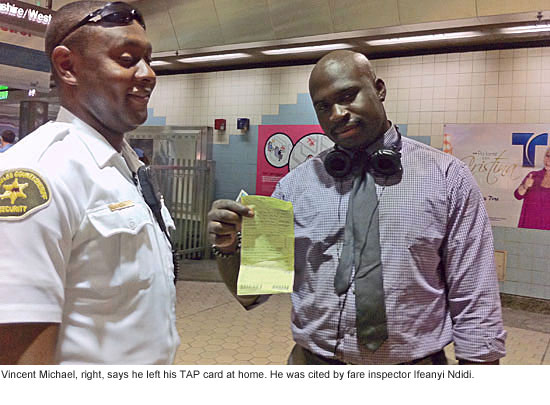 For Conrad Armour, the free ride came to an end Wednesday.
For Conrad Armour, the free ride came to an end Wednesday.
Not that the 23-year-old student was intentionally trying to evade the subway fare; he swears he inadvertently left his monthly pass in his gym locker. But on this particular afternoon, a gym locker was the worst possible place for that pass to be.
Metro officials, preparing for the first time to bring locked turnstile gates to local subway lines, are conducting a pilot test in four stations this month. That means spot-checking passengers’ tickets as they get off trains and monitoring ticket sales as incoming patrons realize they’ll have to pay to ride, or face the consequences. (A ticket for fare evasion can mean a $250 fine.) The test run is intended to explore, among other things, how many fare evaders the locked gate system could turn into paying customers.
As incredible as it might seem to transit riders from other big cities like New York and San Francisco, where locked gates are the time-honored way to prevent or at least slow down fare-beaters, Los Angeles’ subway was designed to operate on the honor system.
In recent years, Metro has taken steps to change that. In 2008, the agency’s board approved installation of a $46 million barrier gate system for L.A.’s Red Line and Purple Line subways as well as some light rail lines. At the time, it was estimated that fare-beaters cost the system $5.5 million a year, and that the system would begin paying for itself in its fourth full year of operation.
By last year, the turnstile gates were all installed but have remained unlocked while the agency tries to figure out how best to implement the new system. Still-unresolved issues include finding ways to handle passengers with paper tickets instead of the widely-used TAP “smart cards” that are designed to open the gates, and to incorporate travelers from other local transit lines that haven’t become part of the TAP network.
There’s also been debate over how far the amount of additional ticket revenue will actually go toward offsetting the cost of changing the system.
On Wednesday, Metro’s team directed patrons coming into the Purple Line’s Wilshire/Western station based on whether they had a TAP card, a paper ticket or no ticket at all. Vending machines appeared to do a brisk business selling to customers who may or may not have been planning to pay.
“It’s a lot more than a handful,” observed Supervisor Zev Yaroslavsky, who dropped by the station Wednesday as part of a small delegation of Metro board members including Santa Monica Councilmember Pam O’Connor, Lakewood Vice Mayor Diane DuBois and representatives from the office of Los Angeles Mayor Antonio Villaraigosa.
As part of the operation, fare enforcement officers were on hand to spot-check for tickets as passengers got off the trains.
While many people showed legitimate tickets or cards, many others did not. And the excuses were flying.
“The stories—some of them are good,” said Daniel Pickering, who along with Ifeanyi Ndidi was checking to make sure people had paid their fares.
Pickering said the body language could be a tip-off, with some patrons putting on an elaborate show of patting down their pockets, avoiding eye contact or rushing by flashing just the back of a ticket.
Some passengers—with and without tickets—got flustered.
“Where is that ******* ticket I got for $5?” one woman said as she angrily rummaged through her things before finally producing a ticket and hurrying on her way.
Another was escorted out of the station in handcuffs after a loud and lengthy exchange that escalated after she refused to sign her citation for fare evasion. (A sheriff’s patrol car was summoned but the woman was released after she finally decided to sign.)
The fare inspectors had the discretion to issue a warning or a citation. For example, a visiting student from France, Nathalie Karouni, was given the chance to purchase a ticket instead of getting a citation. And Isaac Taez, an 18-year-old student at the Friedman Occupational Center, got off with a warning.
Other travelers were slowed down a bit, like the 9th grade girls who had to wait for the one member of their group who’d forgotten her TAP card Wednesday and had to explain herself to the fare inspectors.
Sgt. Jeff Jablonsky, the sheriff’s department’s liaison to the TAP card/gating program, said 53 citations have been given out during the test program so far, with more likely next Wednesday, October 19, when all four of the test stations will be operating with locked gates from 1 p.m. to 4 p.m. (The stations are Wilshire/Normandie and Wilshire/Western on the Purple Line, and Vermont/Beverly and Hollywood/Western on the Red Line.)
In addition, he said, 5 people have been arrested, including a suspected graffiti vandal and a suspect with an outstanding warrant for a narcotics violation.
Jablonsky said that from what he’s heard, the transit-riding public supports locking the gates. “The comment that we’ve heard most of the time is, ‘It’s about time,’ ” Jablonsky said. “And we have other ones who say ‘I’m from New York and our gates are locked all the time. I don’t understand why your gates aren’t locked.’ The public is ready for it.”
That seemed to be the prevailing sentiment among travelers Wednesday. “I use the train, so I should pay for it. Otherwise I should walk,” said Sacha Larrabee, a 33-year-old grad student at Azusa Pacific University.
“It’s better because usually people come down here with nothing—no money, no TAP card,” said Alex Avalos, 18. “It’s like it’s free!” agreed Alyssa Segarra, 19.
Even some of those cited seemed more resigned than angry.
“I have a bus pass!” said Armour, the student who said he’d left the pass in his gym locker. “Unfortunately I just got caught up in it.” He said he was confident he could convince a judge to throw out the ticket when he produces the pass.
Vincent Michael, a 22-year-old security officer, said he also plans to fight his citation.
“I have a TAP card, a valid one, and I forgot it at home today, so I’ll just take it to court,” he said, before offering his support for the locked-gate project.
“It keeps everybody on their toes,” he said. “It makes everybody pay the fare.”
Posted 10/13/11
Missing a $26,234 tax refund?
October 13, 2011
 Los Angeles County is $2.32 million richer this week, thanks to more than 6,000 unclaimed property tax refunds that have nowhere to go but the county’s general fund.
Los Angeles County is $2.32 million richer this week, thanks to more than 6,000 unclaimed property tax refunds that have nowhere to go but the county’s general fund.
State law authorizes counties to keep excess tax payments if no one claims them for four years. So every year about this time—as tax bills go out to millions of Southern Californians—the Treasurer and Tax Collector’s Office reluctantly deposits another pile of money from over-payers who couldn’t be located.
This year’s unclaimed refunds, from 2005-06, were only a tiny fraction of the more than $11 billion collected in the county that tax year. Many were for modest amounts ($1.59 was the smallest), but someone out there also failed to claim a refund worth $26,234.
Los Angeles County Assistant Treasurer and Tax Collector Nai-len W. Ishikawa says the county tries hard to track down recipients of refunds, and gets better at it every year; unclaimed overpayments have steadily declined for the past three years, even though collections rose during the tax periods involved.
But sometimes, the trail just goes cold, she says.
“Sometimes the property owner has passed away,” says Ishikawa. “Sometimes there’s been a change in ownership and we don’t have the person’s address.”
Typically, she says, overpayments occur when a tax bill has been inadvertently double-paid by spouses or a mortgage company and the county lacks sufficient information to generate an automatic refund. This, she added, can happen when the overpayment has been made via cash, a money order or an unaddressed check.
In other cases, the county gets a payment, but can’t apply it because the taxpayer forgot to include the bill stub or to write the parcel number on the check or wrote an invalid number, she says.
Although the vast majority of unclaimed refunds this year—about 5,500 items totaling about $1.43 million—were for overpayments, checks with missing parcel numbers or bill stubs hardly amounted to pocket change. In all, there were 942 of them, totaling about $880,000. The largest was $17,412.
Ishikawa says the county cannot issue a refund without documentation of an overpayment. But, she added, taxpayers can claim their money even after the 4-year deadline if the documentation shows that the county has made a mistake.
Donna Doss, the assistant treasurer and tax collector whose staff processes payments, says unclaimed refunds automatically go into a special file. Staffers in her office then begin the arduous process of finding and notifying the recipient before the 4-year deadline.
“We check our records to see if they own additional property in the county,” Doss says. “We look for any address on file within the county and send letters. We contact the title company.”
About 99% of the overpayments are cleared up, she says: “Often, we are able to locate people and they’re happy to receive their refund.”
But, she adds, staff is limited and searches can’t last forever. Each year, the county generates and processes about 2.3 million property tax bills. Less than one-hundredth of one percent of payments end up with unclaimed refunds.
“Our main mission is to collect taxes, after all,” Doss says. “At some point, you hit diminishing returns.”
Posted 10/13/11







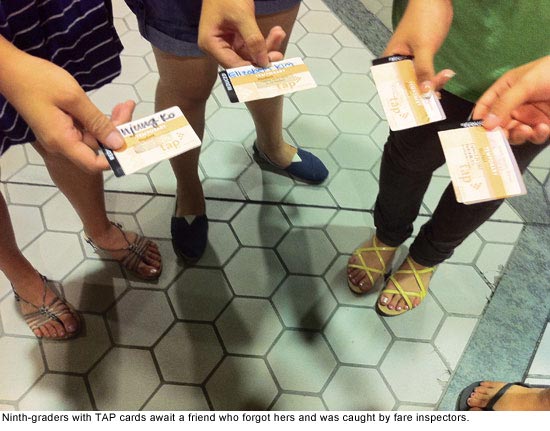





 Check for the latest closure information
Check for the latest closure information








